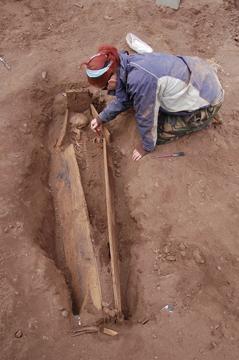Liberty bound: Slavery and St Helena

New exhibition reveals human horror of transatlantic slavery
A dramatic new exhibition at Liverpool’s International Slavery Museum will explore finds from a burial ground of Africans liberated from slavery.
Liberty bound: Slavery and St Helena opens on 4 April 2014 and looks at one of the most important archaeological finds of recent times in one of the most remote places on earth.
This is the first ever exhibition to look at recently re-discovered graveyards containing the remains of 'liberated' Africans in Rupert's Valley, St Helena, in South Atlantic.
Items to go on show at the Museum include coins, jewellery, buttons, iron tags and fragments of clothing. But it’s the human story of the men, women and children that owned these items that visitors will find most moving.
The graveyards were uncovered during archaeological work carried out in advance of an airport development. Between 2007 and 2008 excavations were undertaken by archaeologists from the UK, supported by St Helenian volunteers.
The graveyards were the final resting grounds for liberated Africans freed from illegal slaver-running vessels, or 'slavers', by the Royal Navy's West Africa Squadron in the middle decades of the 19th century.
Many enslaved Africans did not survive the trauma of their transportation and died in British receiving depots on St Helena at Rupert's Valley. Excavations only uncovered a very small proportion of the estimated 8,000 burials of liberated Africans on St Helena.
Dr Richard Benjamin, Head of the International Slavery Museum, said: “This new exhibition will reveal a hitherto unknown but important aspect of the human horror of transatlantic slavery.
“Although remote geographically, Rupert’s Valley, St Helena, is of immense cultural and historic significance. The archaeological investigations enhance our understanding of the transatlantic slave trade and its legacies.
“This exhibition reveals that liberation could be cruel. For those Africans who survived the ordeal of being enslaved, freedom came with a caveat, as most never saw their homelands again.”
This exhibition was developed in collaboration with the Government of St Helena, the Museum of St Helena, the Department for International Development (DFID) and Dr Andrew Pearson (Pearson Archaeology Ltd/ Bristol University).
Dr Pearson said: “From the moment that we began excavating this site its importance was obvious. Archaeologically it is unique, allowing an insight into the transatlantic slave trade that goes far beyond the historical texts and brings us - literally - face to face with the human consequences in the trade of enslaved Africans.”
Lucinda Caesar, Director of the Museum of St Helena, said: “Documented in 1861 and 1872, the presence of liberated African graves on St Helena is well known by St Helenians, as is their importance to our understanding of the transatlantic slave trade.
“This exhibition begins the journey to restore the cultural identity of these people and provides an opportunity for their story to be appreciated beyond their St Helenian descendants and heard beyond the shores of St Helena.”
For more details: www.liverpoolmuseums.org.uk/sthelena Twitter: #StHelena
Notes to editors:
About St Helena
The history of St Helena is fascinating and touches many aspects of world history. Discovered by the Portuguese in 1502, it has since been in British possession, only being briefly taken over by the Dutch in 1633. The island became a port of strategic importance until the opening of the Suez Canal and the advent of steamships.
The island’s remote location meant it was used as a place of exile for key prisoners, including some 6,000 Boers, Chief Dinnizulu, Bahraini princes, and Napoleon, who died on St Helena. The Island also played an important role during the abolition of slavery. This heritage provides a significant legacy of fortifications, remains, historic buildings, and what has been described as “the quintessential Atlantic port” - Jamestown.
Situated in the middle of the South Atlantic Ocean, this small British island territory is one of the remotest places on Earth. Until the airport opens in early 2016, the main way for tourists to get to St Helena is by ship, on the RMS St Helena.
International Slavery Museum
The International Slavery Museum opened in August 2007. It is situated on the third floor of the Merseyside Maritime Museum at the Albert Dock. It is the only national museum in the world to cover transatlantic slavery and its legacies as well as contemporary forms of slavery and enslavement. It is also an international hub for resources on human rights issues and campaigning.
About National Museums Liverpool
National Museums Liverpool comprises eight venues. Our collections are among the most important and varied in Europe and contain everything from Impressionist paintings and rare beetles to a lifejacket from the Titanic. We attract more than 2.7m visitors every year. Our venues are World Museum, Museum of Liverpool, the Walker Art Gallery, Merseyside Maritime Museum, International Slavery Museum, Border Force National Museum, Sudley House and the Lady Lever Art Gallery.
